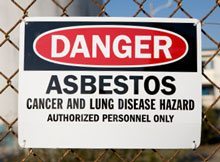Pleural Mesothelioma Rates Remain Stagnant As Survival Improves

A new report shows pleural mesothelioma rates in the US have failed to decline as they were predicted to do, but survival is improving slightly.
The US government began to implement tighter restrictions on asbestos in the 1970s. Researchers at the Cleveland Clinic say original projections had the incidence of pleural mesothelioma peaking in the early 2000s as a result. Pleural mesothelioma rates were supposed to decline after that.
But numbers from the National Cancer Database (NCDB) tell a different story. They suggest that, while mesothelioma survival is improving, incidence of asbestos cancer are not.
Asbestos and Malignant Mesothelioma
Malignant mesothelioma is the most serious of a range of illnesses caused by asbestos. Pleural mesothelioma is the most common type of mesothelioma. These tumors grow on the membrane around the lungs.
As early as the 1930s, doctors started to see a mysterious lung disease among asbestos workers. In 1970, asbestos became one of the first air pollutants to be regulated under the Clean Air Act.
Faced with rising pleural mesothelioma rates, many countries banned asbestos altogether. But US officials hoped that strict regulation would be enough. There is still no asbestos ban in the US.
Analysis of Pleural Mesothelioma Rates
The new analysis included almost 21,000 patients with pleural mesothelioma from the NCDB. The patients were diagnosed between 2004 and 2014.
During that time, pleural mesothelioma rates did not fall as predicted. In fact, the number of cases of pleural mesothelioma rose from 1,783 to 1,961 per year. Pleural mesothelioma now accounts for about one third of one percent (0.03%) of all cancer cases each year.
Mesothelioma has always been more common in men and this is still true. Women make up about a fifth of all pleural mesothelioma cases. But the proportion of mesothelioma patients who are elderly has risen.
There were a few bright spots in the report on pleural mesothelioma rates. One-year mesothelioma survival was 10 percent higher in 2014 than it was in 2004. This is particularly notable since more patients are older.
“National trends suggest that survival is slowly increasing despite an aging cohort,” writes study author Hari Keshava.
More mesothelioma patients are also getting help now. In 2004, only 34 percent of mesothelioma patients sought treatment. By 2014, that had risen to 54 percent.
Factors Influencing Pleural Mesothelioma Survival
The study found that some patients have better odds of survival than others. Women, younger patients, and those with the epithelioid subtype tend to live the longest.
Pleural mesothelioma rates of survival were higher in people who were treated at academic medical centers. Patients who had better health insurance and/or higher incomes also had better outcomes.
Finally, treatment that included several different types of therapies was linked to improved mesothelioma survival.
“Multimodal therapy and treatment at academic centers are modifiable risk factors associated with improved survival,” concludes the report.
Source:
Keshava, H, et al, “Largely Unchanged Annual Incidence and Overall Survival of Pleural Mesothelioma in the USA”, August 19, 2019, World Journal of Surgery, Epub ahead of print, https://link.springer.com/article/10.1007%2Fs00268-019-05132-6





